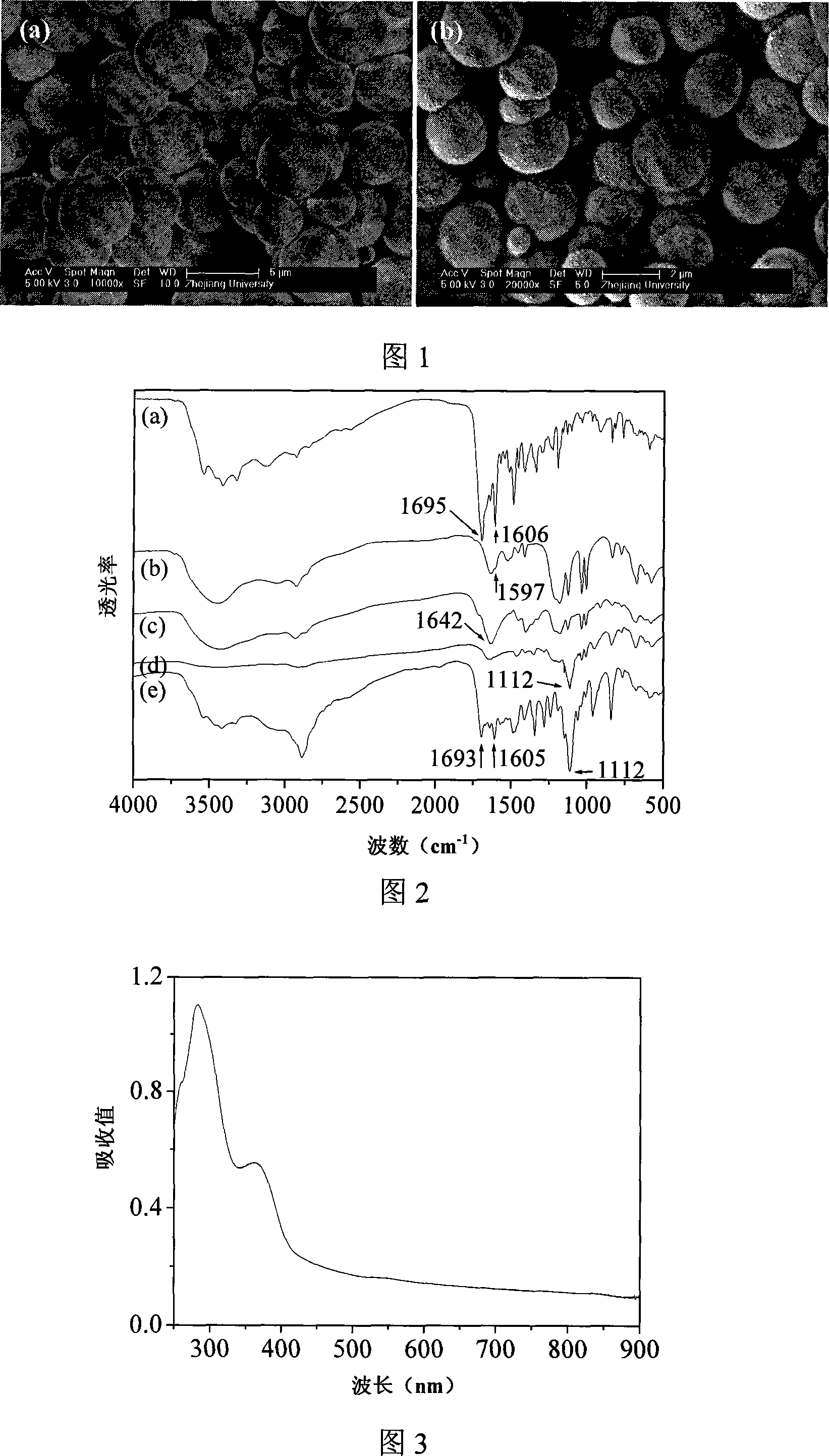Method for preparing microcapsule having function of specific connecting with tumor cell
A tumor cell and microcapsule technology, which is applied in the field of preparing layered structure microcapsules with a function of specific binding to tumor cells, can solve the problems of non-targeting, short biological half-life, tumorigenicity and the like, and achieves a simple preparation process. , mild conditions
- Summary
- Abstract
- Description
- Claims
- Application Information
AI Technical Summary
Problems solved by technology
Method used
Image
Examples
example 1
[0027] 1) Add 50mL of sodium carbonate solution with a concentration of 0.33M / L to 50mL of calcium nitrate solution with a concentration of 0.33M / L; after 15 minutes, the generated calcium carbonate (expressed as CaCO 3 ) colloidal particles were collected by centrifugation, washed 3 times with water, and stored; the prepared CaCO 3 The scanning electron micrograph of the particles is shown in Figure 1(a);
[0028] 2) 1 mL of CaCO obtained in step 1) with a solid content of 5% 3 The microparticles were placed in a 2mL centrifuge tube, centrifuged to remove the supernatant, and washed 3 times with water; add 1mL polyallylamine hydrochloride (PAH) / 0.5M NaCl solution, shake the centrifuge tube, and wash 3 times with water after 10 minutes. Removal of excess PAH, resulting in CaCO 3 A layer of PAH (expressed as CaCO 3 -PAH); Then add 1mL polystyrene sodium sulfonate (PSS) / 0.5M NaCl solution, shake the centrifuge tube, after 10 minutes, wash with water 3 times to remove excess P...
example 2
[0032] 1) prepare microcapsules with example 1, but in 2) in step, common PAH is replaced by rhodamine-labeled PAH (Rd-PAH), the fluorescent probe label that obtains (PAH / PSS) 4 / Rd-PAH microcapsules and (PAH / PSS) 4 / Rd-PAH / PEG / FA microcapsules;
[0033] 2) Human fibroblasts, SMMC-7721 hepatoma cells and human fibroblasts+SMMC-7721 hepatoma cells were respectively planted on 96-well polystyrene culture plates at a planting density of 10,000 / well; 100 μL containing 10 % (v / v) calf serum and 90% (v / v) DMEM medium, 5% CO at 37°C 2 Cultured in humid air; after 24h, add (PAH / PSS) to each well 4 / Rd-PAH microcapsules, (PAH / PSS) 4 / Rd-PAH / PEG / FA microcapsules and (PAH / PSS) 4 / Rd-PAH / PEG / FA microcapsules + 2.5mM free folic acid solution, the concentration of microcapsules is 2×10 7 / well; slightly shake the mixed culture solution of cells and microcapsules, absorb the culture solution after 15 minutes, add 1mL PBS buffer solution to wash twice; observe the adhesion of microcapsul...
example 3
[0037] 1) Add polystyrene sodium sulfonate (PSS) to the calcium nitrate aqueous solution with a concentration of 0.005M / L, and add a sodium carbonate aqueous solution with a concentration of 0.005M / L under stirring, and the final concentration of PSS in the mixture is 0.5mg / L mL, reacted for 5min under stirring, and centrifuged to obtain CaCO containing PSS inside 3 Colloidal particles (CaCO 3 (PSS)), the scanning electron microscope photo is shown in Figure 1(b);
[0038] Step 2) to step 4) are the same as in Example 1 to obtain PSS-(PAH / PSS) suspended in water 4 / PAH / PEG / FA polyelectrolyte hollow microcapsules.
[0039] 5) Set 2.0±0.2×10 7 PSS-(PAH / PSS) 4 / PAH / PEG / FA microcapsules mixed with 0.5mL 1mg / mL doxorubicin (DOX) aqueous solution, incubated at room temperature for 12h, to obtain microcapsules embedded with DOX, the concentration of DOX in the microcapsules was 24.8mg / mL ; PSS-(PAH / PSS) embedded with DOX 4 / PAH / PEG / FA microcapsules were co-incubated with human ...
PUM
 Login to View More
Login to View More Abstract
Description
Claims
Application Information
 Login to View More
Login to View More - R&D
- Intellectual Property
- Life Sciences
- Materials
- Tech Scout
- Unparalleled Data Quality
- Higher Quality Content
- 60% Fewer Hallucinations
Browse by: Latest US Patents, China's latest patents, Technical Efficacy Thesaurus, Application Domain, Technology Topic, Popular Technical Reports.
© 2025 PatSnap. All rights reserved.Legal|Privacy policy|Modern Slavery Act Transparency Statement|Sitemap|About US| Contact US: help@patsnap.com



